The Third Sector: The “Other” Actors of Rural Development, Andalusia 2000–2015
Abstract
:1. Introduction
2. Sources, Methodology, and Study Area
3. Results
3.1. The Projects Carried Out by “Others”
3.1.1. Number of Projects and Their Level of Implementation
3.1.2. Investment
3.2. What Type of Projects Did They Carry Out?
3.3. Where Do the “Others” Carry Out Their Projects?
3.3.1. Projects Attributed to Specific Municipalities and Their Level of Implementation
3.3.2. Levels of Investment
3.4. Where Do the “Others” Invest?
3.4.1. Successful and Failed Projects
3.4.2. Executed Projects
3.4.3. With Regard to the Investment Made
4. Discussion and Conclusions
Author Contributions
Funding
Institutional Review Board Statement
Informed Consent Statement
Data Availability Statement
Acknowledgments
Conflicts of Interest
References
- Bassi, A.; Fabbri, A. Under Pressure: Evolution of the Social Economy Institutional Recognition in the EU. Ann. Public Coop. Econ. 2020, 91, 411–433. [Google Scholar] [CrossRef]
- Cafferata, R. Nonprofit Organizations, Privatization and the Mixed Economy: A Managerial Economics Perspective. Ann. Public Coop. Econ. 2002, 68, 665–688. [Google Scholar] [CrossRef]
- Rose-Ackerman, S. Altruism, Nonprofits, and Economic Theory. J. Econ. Lit. 1996, 34, 701–728. [Google Scholar]
- Lam, M. Public Leadership Under Resource Constraints: An Examination of the U.S. Nonprofit Sector. J. Leadersh. Stud. 2020, 14, 89–95. [Google Scholar] [CrossRef]
- Etxezarreta, E.; Bakaikoa, B. Changes in the Welfare State and Their Impact on the Social Economy: Contributions to the Theoretical Debate from a Systemic and Comparative Approach. Ann. Public Coop. Econ. 2012, 83, 259–280. [Google Scholar] [CrossRef]
- Pestoff, V. Towards a Paradigm of Democratic Participation: Citizen Participation and Co-Production of Personal Social Services in Sweden. Ann. Public Coop. Econ. 2009, 80, 197–224. [Google Scholar] [CrossRef]
- Makkonen, T.; Kahila, P. Vitality Policy as a Tool for Rural Development in Peripheral Finland. Growth Chang. 2021, 52, 706–726. [Google Scholar] [CrossRef]
- Hudson, R. New Geographies and Forms of Work and Unemployment and Public Policy Innovation in Europe. Tijdschr. Econ. Soc. Geogr. 2002, 93, 316–335. [Google Scholar] [CrossRef]
- Rantamäki, N.; Kattilakoski, M. On the Trail of Local Welfare Innovations in Rural Finland. Reg. Sci. Policy Pract. 2019, 11, 329–343. [Google Scholar] [CrossRef]
- Shucksmith, M. Endogenous Development, Social Capital and Social Inclusion: Perspectives from LEADER in the UK. Sociol. Rural. 2002, 40, 208–218. [Google Scholar] [CrossRef]
- Ray, C. Neo-Endogenous Rural Development in the EU. In The Handbook of Rural Studies; SAGE Publications Ltd.: London, UK, 2006. [Google Scholar]
- Steiner, A.; Teasdale, S. Unlocking the Potential of Rural Social Enterprise. J. Rural Stud. 2019, 70, 144–154. [Google Scholar] [CrossRef]
- European Commission; Directorate-General for Agriculture and Rural Development. Leader Approach A Basic Guide; Publications Office: Luxembourg, 2006; ISBN 978-92-79-02044-5. [Google Scholar]
- Furmankiewicz, M.; Janc, K.; Macken-Walsh, Á. The Impact of EU Governance and Rural Development Policy on the Development of the Third Sector in Rural Poland: A Nation-Wide Analysis. J. Rural Stud. 2016, 43, 225–234. [Google Scholar] [CrossRef]
- Shucksmith, M.; Brooks, E.; Madanipour, A. LEADER and Spatial Justice. Sociol. Rural. 2021, 61, 322–343. [Google Scholar] [CrossRef]
- Steiner, A.; Calò, F.; Shucksmith, M. Rurality and Social Innovation Processes and Outcomes: A Realist Evaluation of Rural Social Enterprise Activities. J. Rural Stud. 2021, in press. [Google Scholar] [CrossRef]
- Olmedo, L.; van Twuijver, M.; O’Shaughnessy, M. Rurality as Context for Innovative Responses to Social Challenges–The Role of Rural Social Enterprises. J. Rural Stud. 2021, in press. [Google Scholar] [CrossRef]
- Richter, R. Rural Social Enterprises as Embedded Intermediaries: The Innovative Power of Connecting Rural Communities with Supra-Regional Networks. J. Rural Stud. 2019, 70, 179–187. [Google Scholar] [CrossRef]
- Vercher, N.; Barlagne, C.; Hewitt, R.; Nijnik, M.; Esparcia, J. Whose Narrative Is It Anyway? Narratives of Social Innovation in Rural Areas – A Comparative Analysis of Community-Led Initiatives in Scotland and Spain. Sociol. Rural. 2021, 61, 163–189. [Google Scholar] [CrossRef]
- Furmankiewicz, M.; Macken-Walsh, Á. Government within Governance? Polish Rural Development Partnerships through the Lens of Functional Representation. J. Rural Stud. 2016, 46, 12–22. [Google Scholar] [CrossRef]
- Navarro, F.; Woods, M.; Cejudo, E. The LEADER Initiative Has Been a Victim of Its Own Success. The Decline of the Bottom-Up Approach in Rural Development Programmes. The Cases of Wales and Andalusia. Sociol. Rural. 2015, 56, 270–288. [Google Scholar] [CrossRef]
- Ostrom, E. El Gobierno de Los Bienes Comunes: La Evolución de las Instituciones de Acción Colectiva; Fondo de Cultura Económica: México City, México, 2000; ISBN 978-607-16-0617-4. [Google Scholar]
- Ostrom, E.; Vallina, M.M. Comprender La Diversidad Institucional; Elibro Catedra; Fondo de Cultura Económica, KRK Ediciones: Oviedo, España, 2015; ISBN 978-607-16-2554-0. [Google Scholar]
- Lovell, S.A.; Gray, A.; Boucher, S.E. Economic Marginalization and Community Capacity: How Does Industry Closure in a Small Town Affect Perceptions of Place? J. Rural Stud. 2018, 62, 107–115. [Google Scholar] [CrossRef]
- Kluvankova, T.; Nijnik, M.; Spacek, M.; Sarkki, S.; Perlik, M.; Lukesch, R.; Melnykovych, M.; Valero, D.; Brnkalakova, S. Social Innovation for Sustainability Transformation and Its Diverging Development Paths in Marginalised Rural Areas. Sociol. Rural. 2021, 61, 344–371. [Google Scholar] [CrossRef]
- Bourqia, R.; Sili, M. A Kaleidoscope of Ideas for Rethinking Development in the Global South. In New Paths of Development: Perspectives from the Global South; Bourqia, R., Sili, M., Eds.; Sustainable Development Goals Series; Springer International Publishing: Cham, Switzerland, 2021; pp. 1–21. ISBN 978-3-030-56096-6. [Google Scholar]
- Islam, S.M. Impact Investing in Social Sector Organisations: A Systematic Review and Research Agenda. Account. Financ. 2021, n/a, 1–29. [Google Scholar] [CrossRef]
- OECD. The New Rural Paradigm: Policies and Governance; OECD Publishing: Paris, France, 2006. [Google Scholar]
- Molinero Hernando, F. El espacio rural de España: Evolución, delimitación y clasificación. Cuad. Geogr. 2019, 58, 19–56. [Google Scholar] [CrossRef]
- De Cos Guerra, O.; Reques Velasco, P. Vulnerabilidad Territorial y Demográfica En España. Posibilidades Del Análisis Multicriterio y La Lógica Difusa Para La Definición de Patrones Espaciales. Investig. Reg.-J. Reg. Res. 2019, 2019, 201–225. [Google Scholar]
- Reig Martínez, E.; Goerlich Gisbert, F.J.; Cantarino Martí, I. Delimitación de Áreas Rurales y Urbanas a Nivel Local: Demografía, Coberturas del Suelo y Accesibilidad; Fundación BBVA: Bilbao, España, 2016. [Google Scholar]
- Brezzi, M.; Dijkstra, L.; Ruiz, V. OECD Extended Regional Typology: The Economic Performance of Remote Rural Regions. OECD Reg. Dev. Work. Pap. 2011, 2011/06, 1–21. [Google Scholar] [CrossRef]
- Del Valle Ramos, C.; Almoguera Sallent, P. Envejecimiento Demográfico y (Des)Población En Las Ciudades Medias Interiores de Andalucía (2008–2018). Cuad. Geogr. 2020, 59, 263–283. [Google Scholar] [CrossRef]
- Cañete Pérez, J.A.; Cejudo García, E.; Navarro Valverde, F.A. Proyectos fallidos de desarrollo rural en Andalucía. Boletín de la Asociación de Geógrafos Españoles 2018, 78, 270–301. [Google Scholar] [CrossRef] [Green Version]
- Cejudo, E.; Cañete, J.; Navarro, F.; Moya, N. Entrepreneurs and Territorial Diversity: Success and Failure in Andalusia 2007–2015. Land 2020, 9, 262. [Google Scholar] [CrossRef]
- Cañete, J.; Navarro, F.; Cejudo, E. Territorially Unequal Rural Development: The Cases of the LEADER Initiative and the PRODER Programme in Andalusia (Spain). Eur. Plan. Stud. 2018, 26, 726–744. [Google Scholar] [CrossRef]
- Cejudo García, E.; Navarro Valverde, F.A.; Camacho Ballesta, J.A. Perfil y características de los beneficiarios finales de los Programas de Desarrollo Rural en Andalucía. LEADER+ y PRODER2 (2000–2006). Cuad. Geogr. 2017, 56, 155–175. [Google Scholar] [CrossRef]
- Bidet, E.; Eum, H. Une Analyse Socio-économique de La Trajectoire Institutionnelle de l’entreprise Sociale: Le Cas de La Corée Du Sud. Ann. Public Coop. Econ. 2020, 2020, 12310. [Google Scholar] [CrossRef]
- Hahn, S.; McCabe, A. Welfare-to-work and the Emerging Third Sector in South Korea: Korea’s Third Way? Int. J. Soc. Welf. 2006, 15, 314–320. [Google Scholar] [CrossRef]
- Monzon, J.; Chaves-Avila, R. The European Social Economy: Concept and Dimensions of the Third Sector. Ann. Public Coop. Econ. 2008, 79, 549–577. [Google Scholar] [CrossRef]
- Fundación La Caixa, ESADE y PwC. La Reacción Del Tercer Sector Social al Entorno de Crisis; PwC, Exade, La Caixa: Valencia, Spain, 2014; p. 76. [Google Scholar]
- Chaney, P.; Wincott, D. Envisioning the Third Sector’s Welfare Role: Critical Discourse Analysis of ‘Post-Devolution’ Public Policy in the UK 1998–2012. Soc. Policy Adm. 2014, 48, 757–781. [Google Scholar] [CrossRef]
- Darby, S. Dynamic Resistance: Third-Sector Processes For Transforming Neoliberalization. Antipode 2016, 48, 977–999. [Google Scholar] [CrossRef]
- Puzuelo-Monfort, J. The Monfort Plan; John Wiley & Sons: Hoboken, NJ, USA, 2012; ISBN 978-1-119-19746-1. [Google Scholar]
- Valentinov, V. Non-Market Institutions in Economic Development: The Role of the Third Sector. Dev. Chang. 2008, 39, 477–485. [Google Scholar] [CrossRef]
- Cheverton, J. Holding Our Own: Value and Performance in Nonprofit Organisations. Aust. J. Soc. Issues 2007, 42, 427–436. [Google Scholar] [CrossRef]
- Onyx, J. Organizations, Voluntary. In The Blackwell Encyclopedia of Sociology; American Cancer Society: Atlanta, GA, USA, 2019; pp. 1–4. ISBN 978-1-4051-6551-8. [Google Scholar]
- Wilson-Thomas, J. Time’s up: Analyzing the Feminist Potential of Time Banks. Gend. Work Organ. 2021, 28, 2114–2131. [Google Scholar] [CrossRef]
- Fyfe, N.R. Making Space for “Neo-Communitarianism”? The Third Sector, State and Civil Society in the UK. Antipode 2005, 37, 536–557. [Google Scholar] [CrossRef]
- Collister, S. Social Media and The Third Sector; Waddington, S., Ed.; John Wiley & Sons, Inc.: New York, NY, USA, 2015; pp. 221–228. ISBN 978-1-118-40484-3. [Google Scholar] [CrossRef]
- Thompson, P.; Williams, R.; Kwong, C. Factors Holding Back Small Third Sector Organizations’ Engagement with the Local Public Sector. Nonprofit Manag. Leadersh. 2017, 27, 513–531. [Google Scholar] [CrossRef]
- Shortall, S.; McKee, A.; Sutherland, L.-A. The Performance of Occupational Closure: The Case of Agriculture and Gender. Sociol. Rural. 2020, 60, 40–57. [Google Scholar] [CrossRef]
- Leyshon, M.; Leyshon, C.; Walker, T.; Fish, R. More than Sweat Equity: Young People as Volunteers in Conservation Work. J. Rural Stud. 2021, 81, 78–88. [Google Scholar] [CrossRef]
- Yarker, S.; Heley, J.; Jones, L. Stewardship of the Rural: Conceptualising the Experiences of Rural Volunteering in Later Life. J. Rural Stud. 2020, 76, 184–192. [Google Scholar] [CrossRef]
- Dell’Olio, M.; Hassink, J.; Vaandrager, L. The Development of Social Farming in Italy: A Qualitative Inquiry across Four Regions. J. Rural Stud. 2017, 56, 65–75. [Google Scholar] [CrossRef]
- Elsen, S.; Fazzi, L. Extending the Concept of Social Farming: Rural Development and the Fight against Organized Crime in Disadvantaged Areas of Southern Italy. J. Rural Stud. 2021, 84, 100–107. [Google Scholar] [CrossRef]
- Klärner, A.; Knabe, A. Social Networks and Coping with Poverty in Rural Areas. Sociol. Rural. 2019, 59, 447–473. [Google Scholar] [CrossRef]
- Dijkstra, L.; Garcilazo, E.; McCann, P. The Effects of the Global Financial Crisis on European Regions and Cities. J. Econ. Geogr. 2015, 15, 935–949. [Google Scholar] [CrossRef]
- Copus, A.; Kahila, P.; Fritsch, M.; Dax, T.; Kovács, K.; Tagai, G.; Weber, R.; Grunfelder, J.; Löfving, L.; Moodie, J. ESCAPE. European Shrinking Rural Areas: Challenges, Actions and Perspectives for Territorial Governance: Applied Research; Final Report. Version 21/12/2020; ESPON: Luxembourg, 2020. [Google Scholar]
- Mahon, M.; Hyyryläinen, T. Rural Arts Festivals as Contributors to Rural Development and Resilience. Sociol. Rural. 2019, 59, 612–635. [Google Scholar] [CrossRef]
- Larrubia Vargas, R.; Natera Rivas, J.J. Envejecimiento y Masculinización de La Población Rural Andaluza. In Despoblación y Transformaciones Sociodemográficas de los Territorios Rurales: Los Casos de España, Italia y Francia; Cejudo, E., Navarro, F.A., Eds.; Universidad de Salento: Lecce, Italy, 2020; pp. 121–152. ISBN 978-88-8305-157-9. [Google Scholar]
- Kumpulainen, K.; Soini, K. How Do Community Development Activities Affect the Construction of Rural Places? A Case Study from Finland. Sociol. Rural. 2019, 59, 294–313. [Google Scholar] [CrossRef]
- Nogué, J. El reencuentro con el lugar: Nuevas ruralidades, nuevos paisajes y cambio de paradigma. Doc. D’anal. Geogr. 2016, 62, 489–502. [Google Scholar] [CrossRef]
- Coram, V.; Louth, J.; Tually, S.; Goodwin-Smith, I. Community Service Sector Resilience and Responsiveness during the COVID-19 Pandemic: The Australian Experience. Aust. J. Soc. Issues 2021, 56, 559–578. [Google Scholar] [CrossRef] [PubMed]
- Martins, V.; Ferreira, M.; Braga, V. The Role of the Fourth Sector in the Context of the COVID-19 Pandemic. Strateg. Chang. 2021, 30, 179–184. [Google Scholar] [CrossRef]
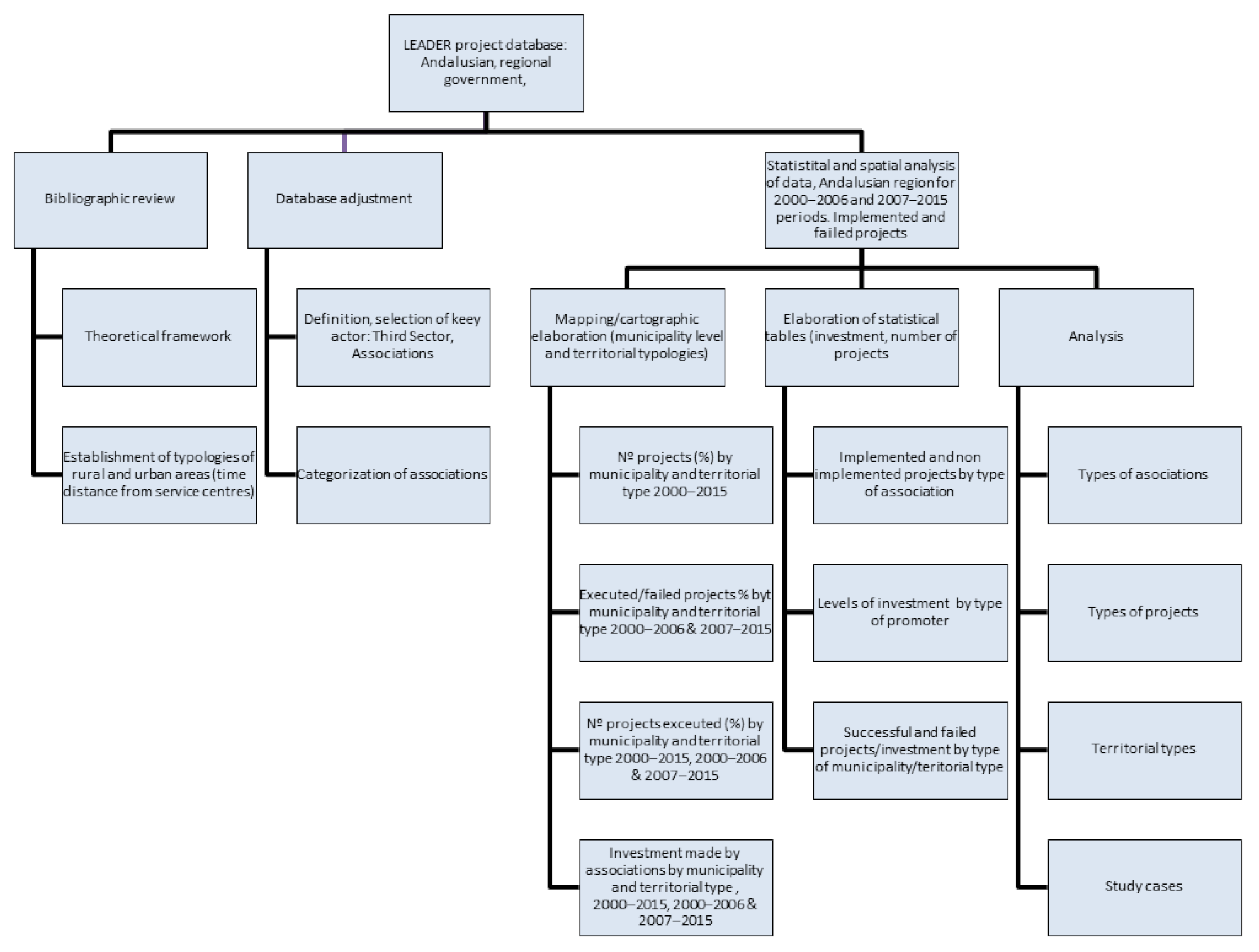
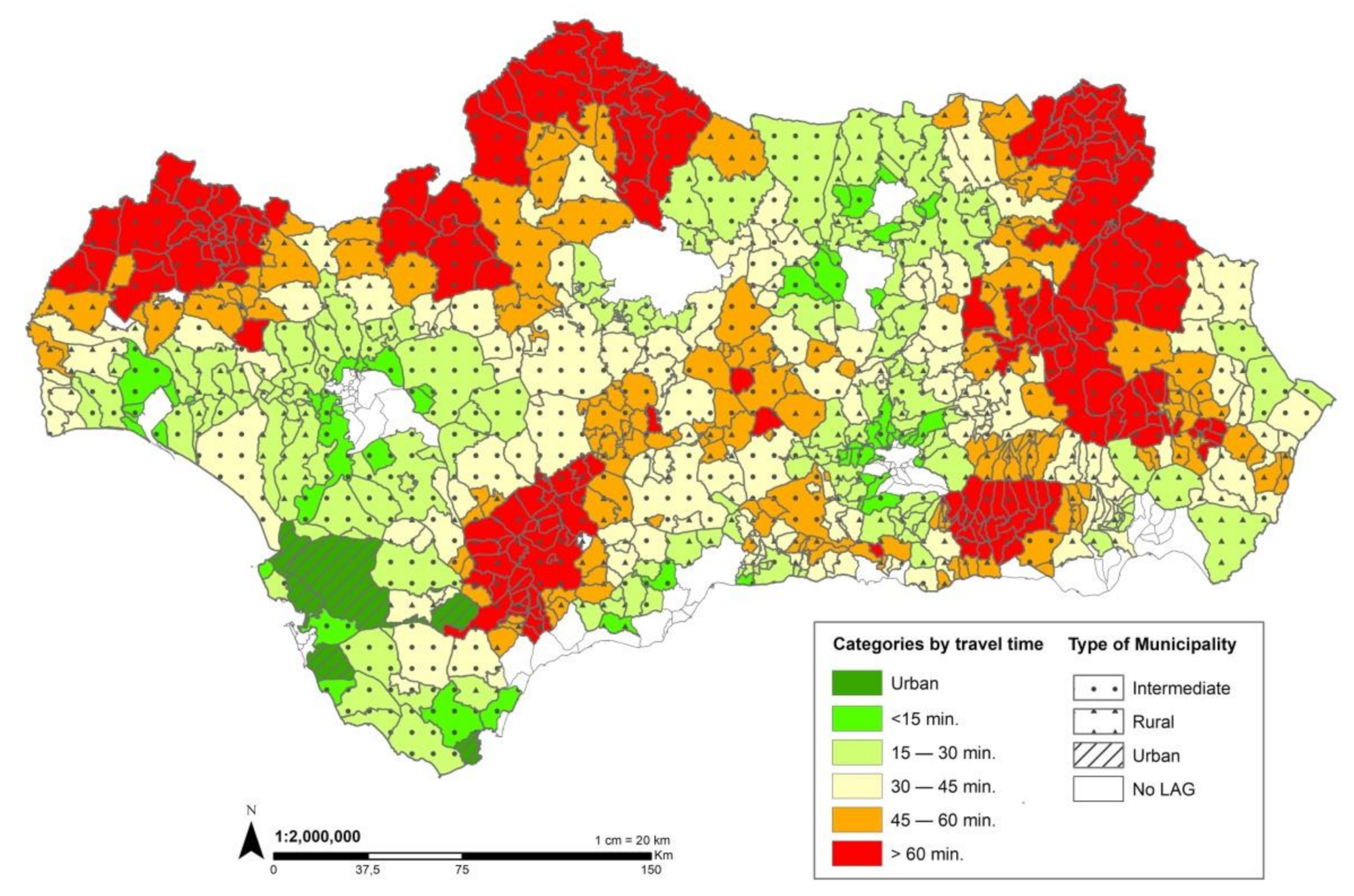
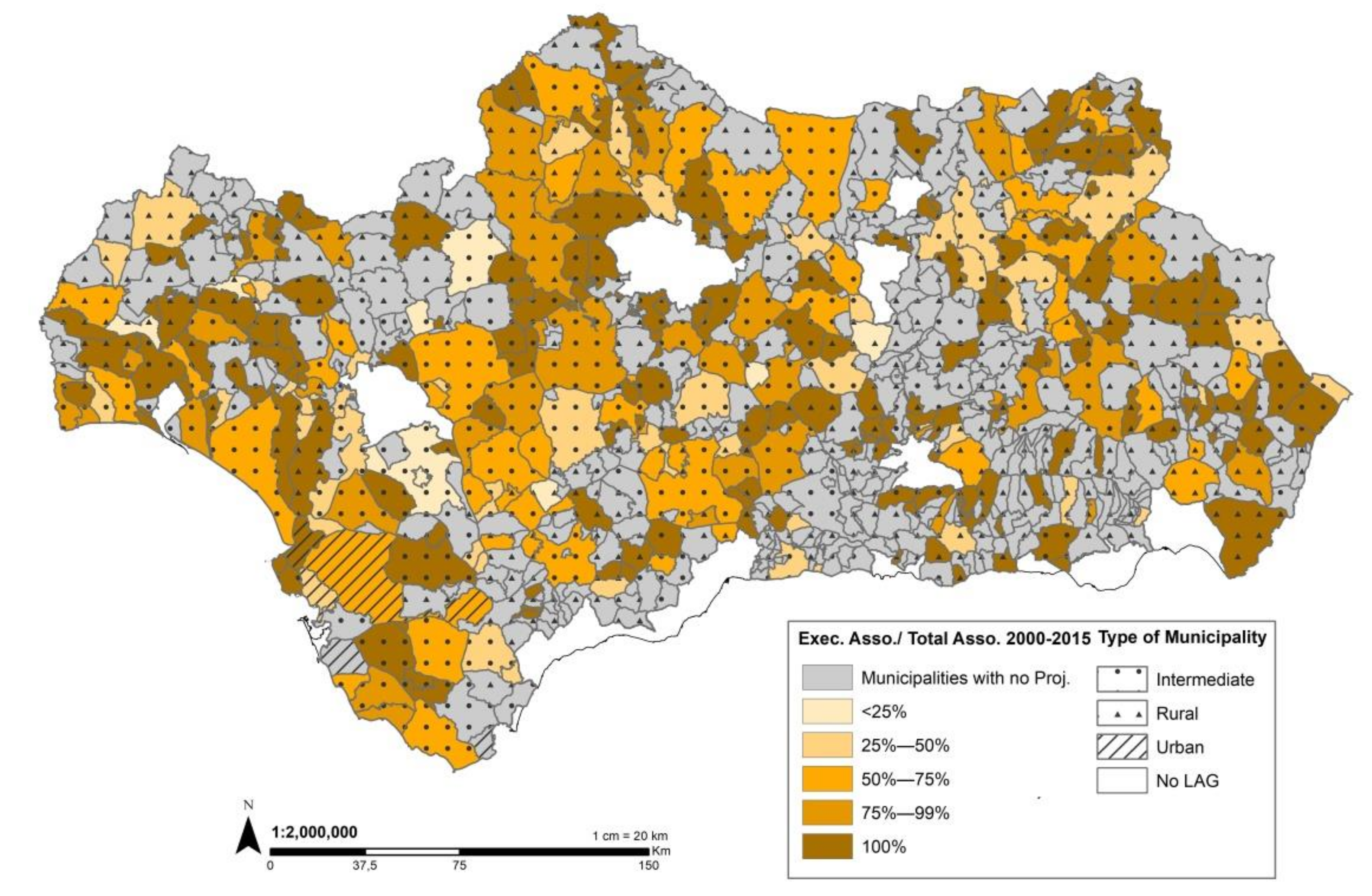
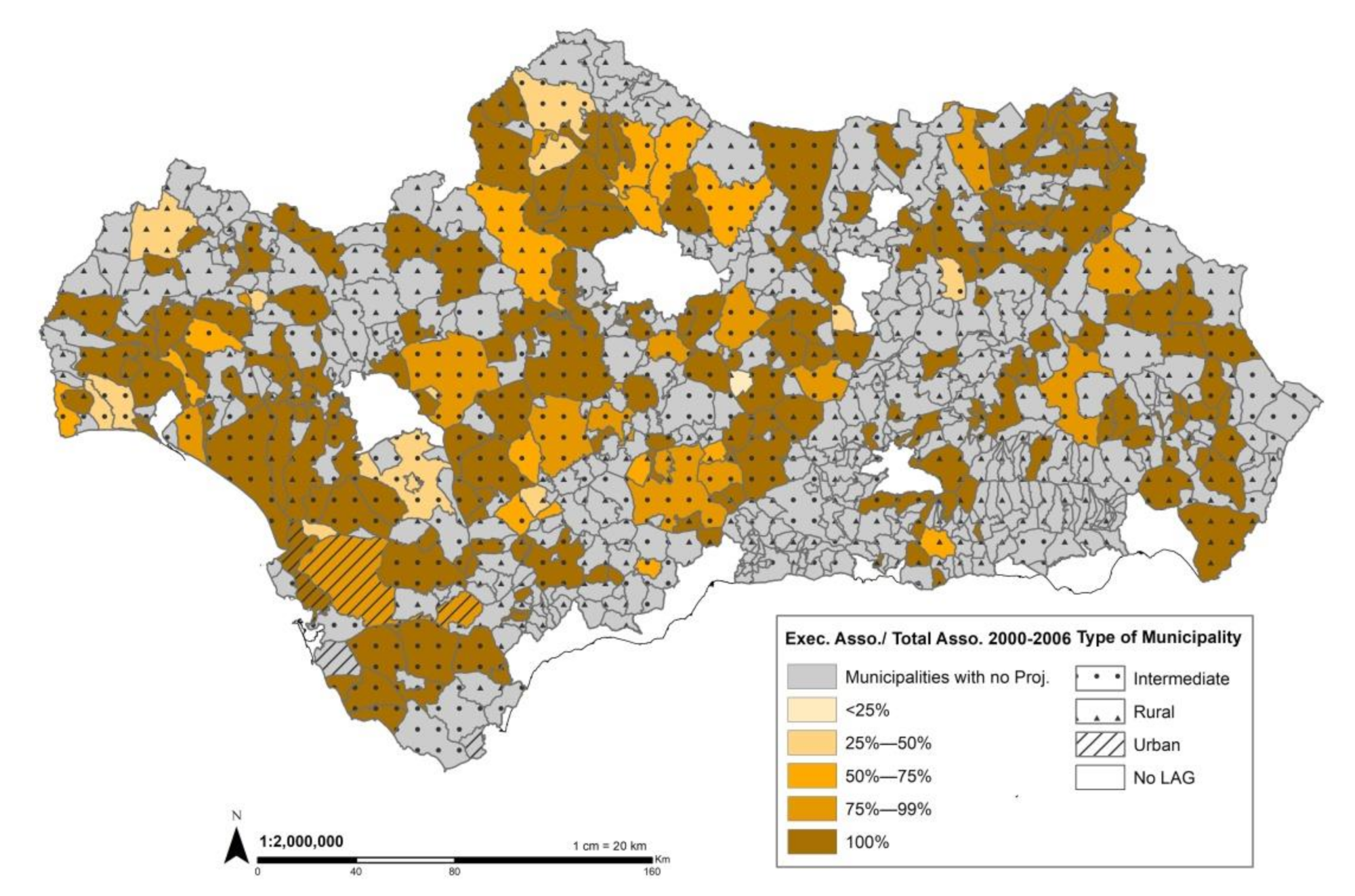

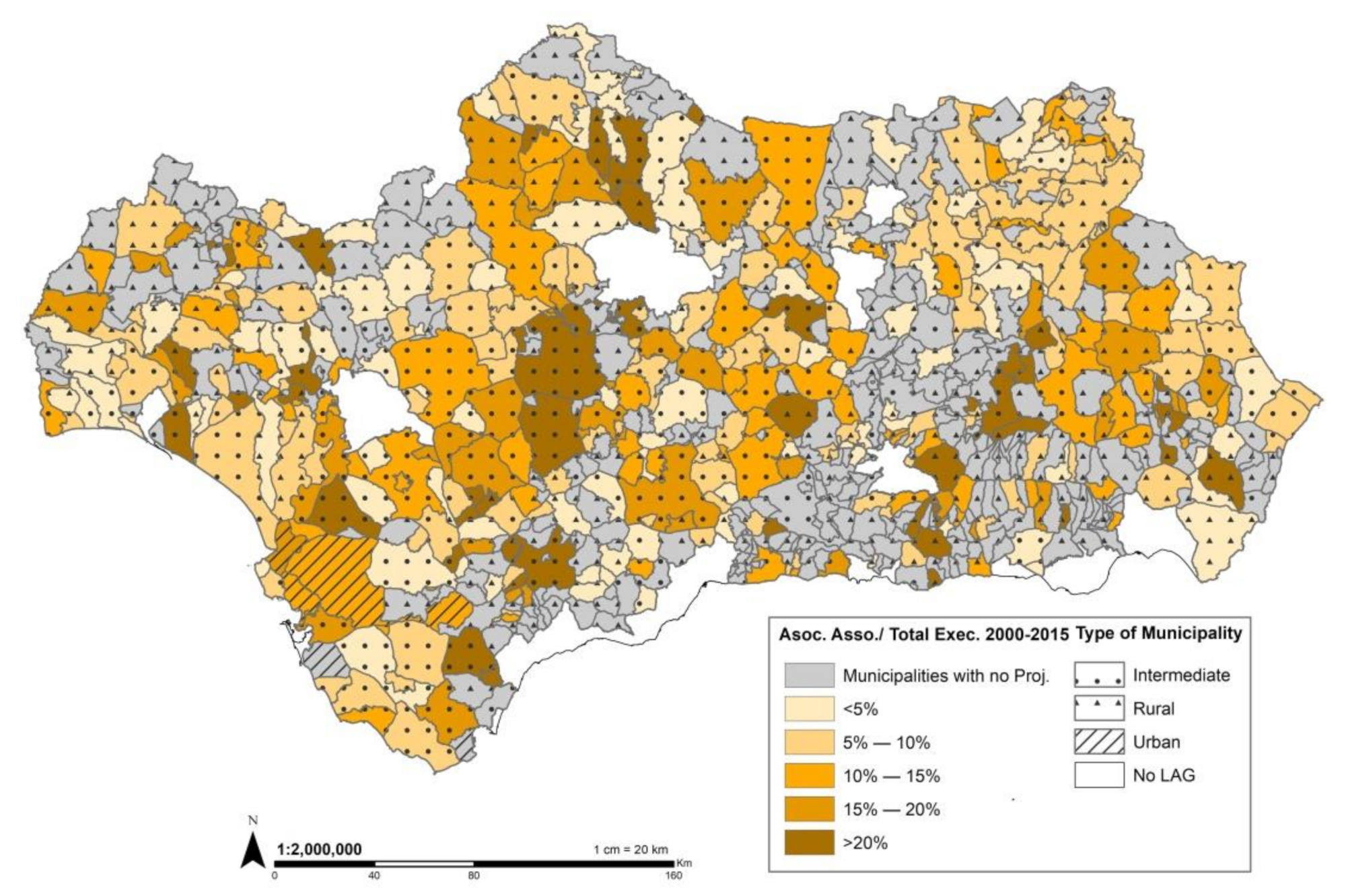
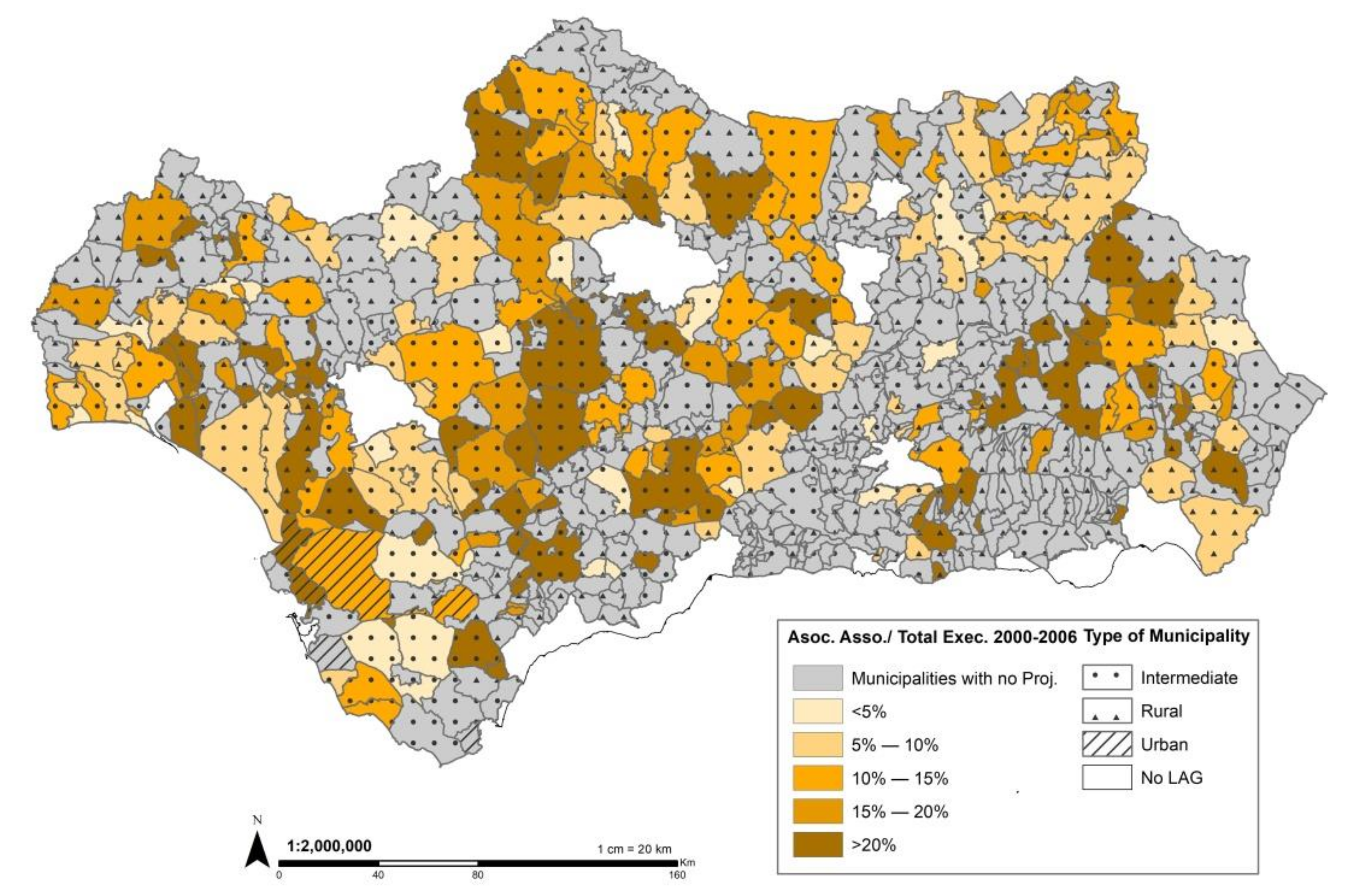
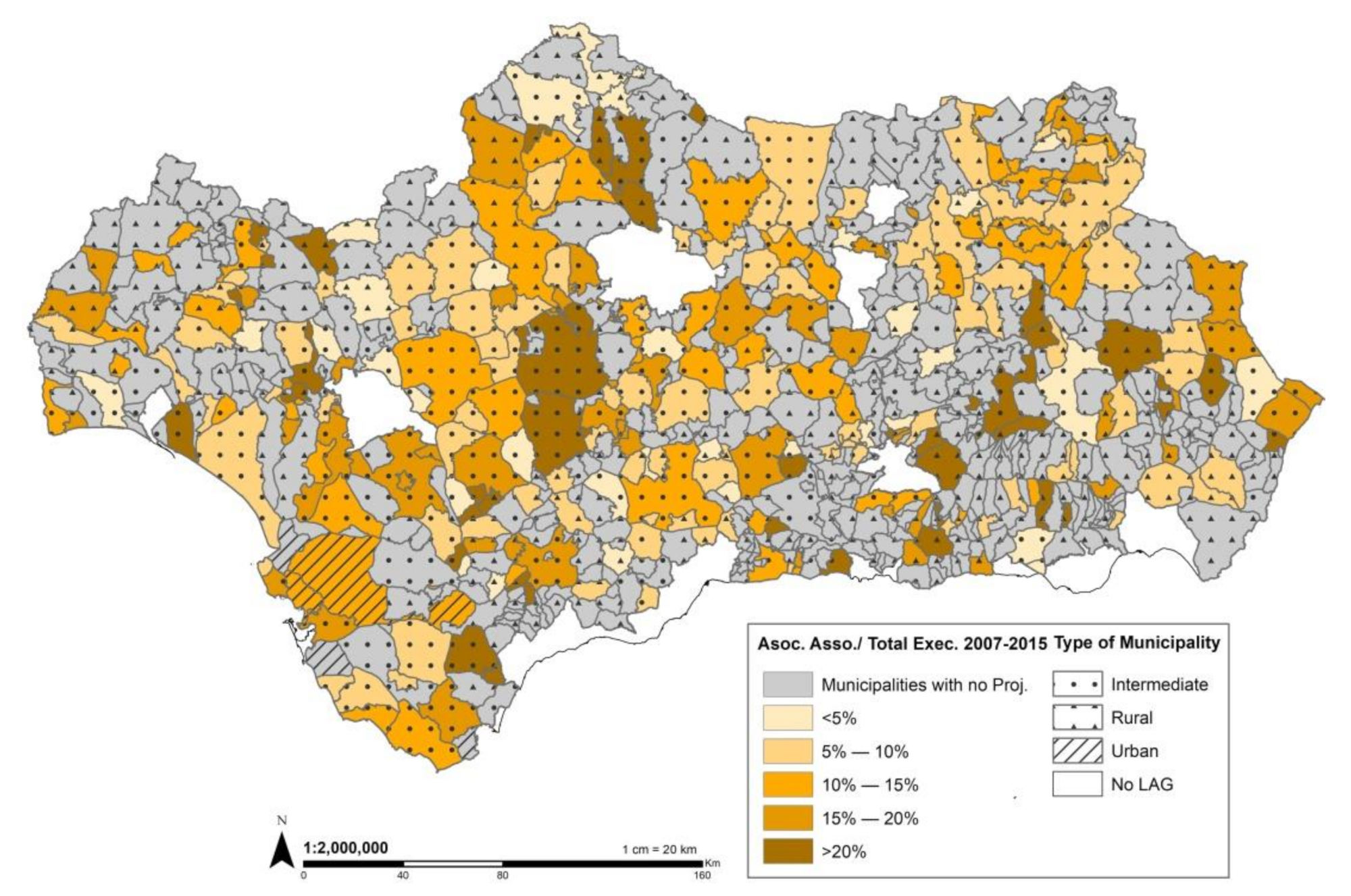
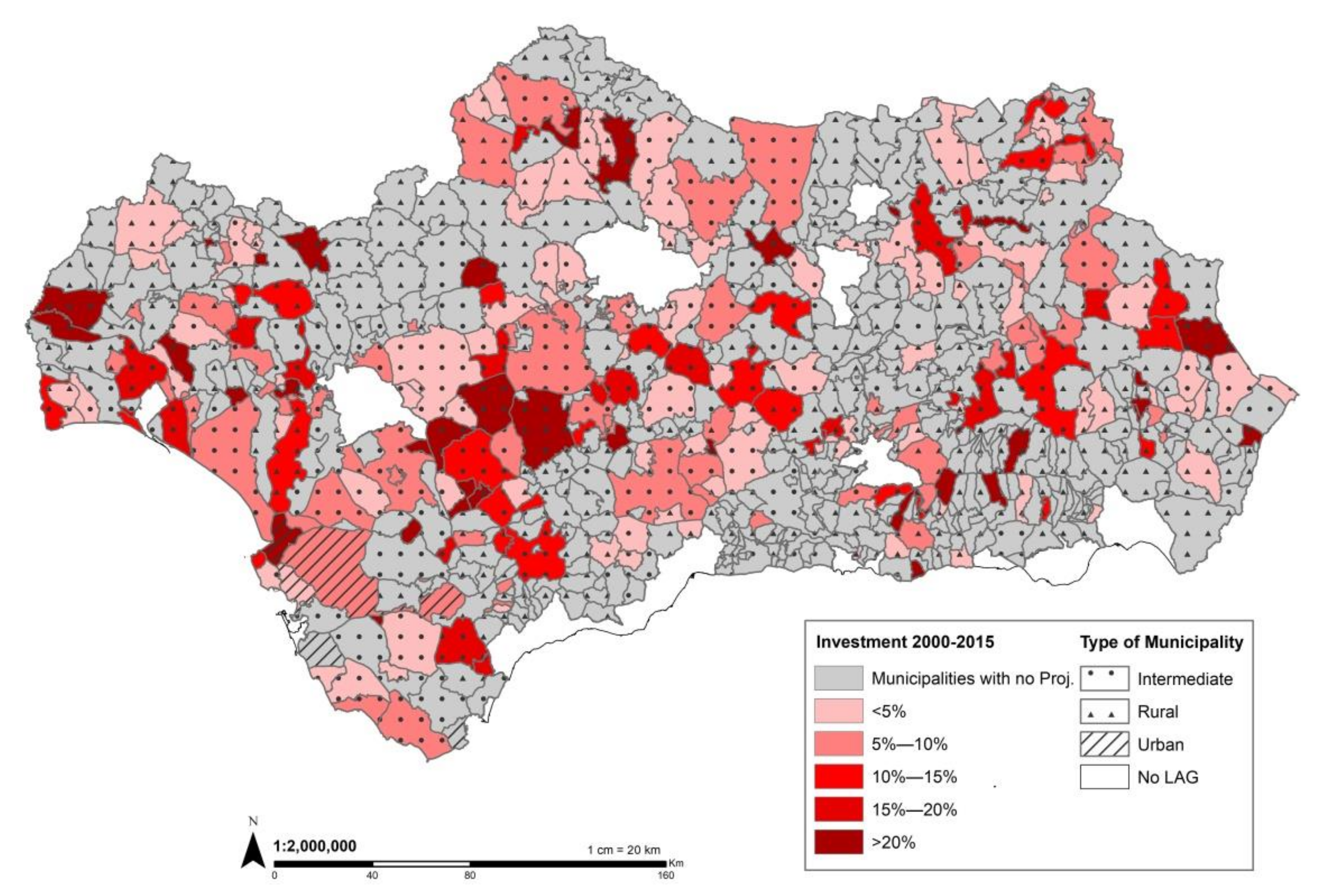

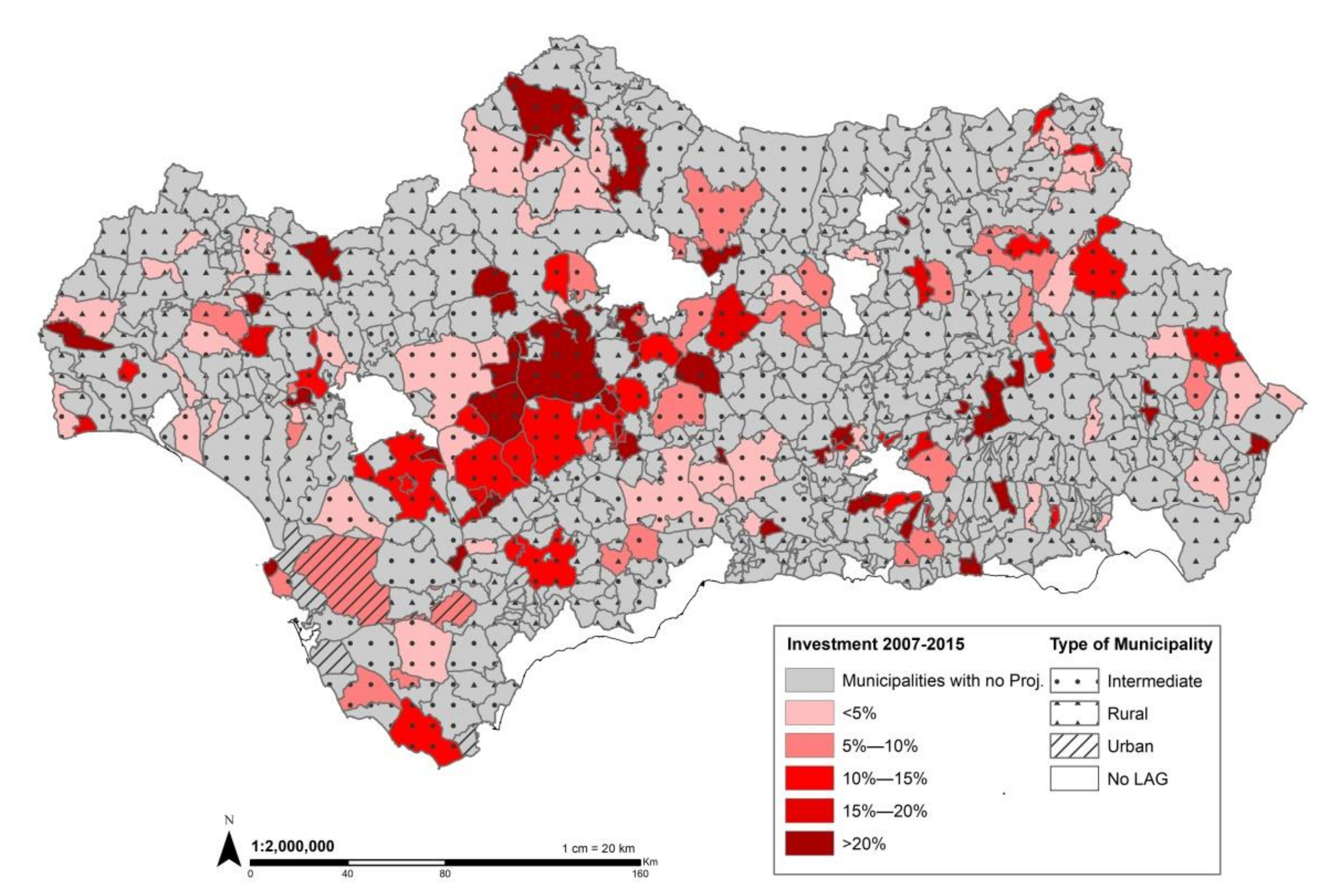
| N° | Identification |
|---|---|
| I | Business associations |
| II | Women’s associations |
| III | Young People’s associations |
| IV | Associations helping vulnerable people/cooperation |
| V | Cultural and leisure associations |
| VI | Neighborhood associations |
| VII | Religious associations |
| VIII | Trade union associations |
| IX | Educational associations |
| X | PGI Control Bodies |
| Variables | Type 1 Urban | Type 2 <15 | Type 3 15 < 30 | Type 4 30 < 45 | Type 5 45 < 60 | Type 6 ≥60 | Total |
|---|---|---|---|---|---|---|---|
| N° Municipalities | 46 | 68 | 168 | 170 | 156 | 165 | 773 |
| Area (Km2) | 5896 | 4515 | 21,131 | 21,225 | 15,735 | 19,284 | 87,786 |
| Population (thousands) | 4,158,201 | 791,075 | 1,505,990 | 1,042,169 | 534,866 | 357,543 | 8,389,844 |
| Density (inhab/Km2) | 705 | 175 | 71 | 49 | 34 | 19 | 96 |
| Travel time (minutes) | 4 | 11 | 23 | 38 | 52 | 73 | 40 |
| Altitude (m) | 259 | 363 | 361 | 477 | 601 | 713 | 504 |
| Women (%) | 51.5 | 49.7 | 49.2 | 49.8 | 49.7 | 49.7 | 50.5 |
| Men (%) | 48.5 | 50.3 | 50.8 | 50.2 | 50.3 | 50.3 | 49.5 |
| Av. Pop/Municipality | 90,396 | 11,633 | 8964 | 6130 | 3429 | 2167 | 10,854 |
| Real Growth 2015–2007 | 168,940 | 92,006 | 99,428 | 20,049 | –8765 | –19,103 | 352,555 |
| Real Growth 2011–1961 | 2,033,778 | 421,615 | 407,367 | –53,505 | –172,322 | –251,118 | 2,385,814 |
| Age 0–14 (%) | 16.3 | 18.3 | 17.0 | 15.6 | 14.4 | 13.6 | 16.3 |
| Age 15–64 (%) | 68.9 | 69.8 | 69.1 | 67.3 | 66.4 | 65.2 | 68.5 |
| Age ≥65 (%) | 14.8 | 11.9 | 13.9 | 17.2 | 19.2 | 21.2 | 15.2 |
| Ageing Index | 90 | 65 | 82 | 110 | 133 | 155 | 93 |
| Average Age | 38 | 38 | 41 | 43 | 45 | 46 | 43 |
| % Affil. Gen. Reg.* | 80 | 57 | 43 | 38 | 35 | 34 | 63 |
| % Affil. Agric. Reg.* | 2 | 19 | 35 | 42 | 44 | 42 | 18 |
| Promotor | 2000–2006 | 2007–2015 | 2000–2015 | |||||||||
|---|---|---|---|---|---|---|---|---|---|---|---|---|
| Imp | Non Imp | Total | Succ | Imp | Non Imp | Total | Succ | Imp | Non Imp | Total | Succ | |
| Business associations | 255 | 28 | 283 | 9.1 | 128 | 228 | 356 | 0.6 | 383 | 256 | 639 | 1.5 |
| Women’s associations | 64 | 6 | 70 | 10.7 | 35 | 52 | 87 | 0.7 | 99 | 58 | 157 | 1.7 |
| Young People’s associations | 5 | 0 | 5 | 100.0 | 12 | 4 | 16 | 3.0 | 17 | 2 | 21 | 4.3 |
| Associations helping vulnerable people and cooperations | 92 | 10 | 102 | 9.2 | 72 | 82 | 154 | 0.9 | 164 | 92 | 256 | 1.8 |
| Cultural and leisure associations | 156 | 22 | 178 | 7.1 | 100 | 136 | 236 | 0.7 | 256 | 158 | 414 | 1.6 |
| Neighborhood associations | 51 | 5 | 56 | 10.2 | 20 | 26 | 46 | 0.8 | 71 | 31 | 102 | 2.3 |
| Religious associations | 102 | 6 | 108 | 17.0 | 60 | 48 | 108 | 1.3 | 162 | 54 | 216 | 3.0 |
| Trade union associations | 67 | 6 | 73 | 11.2 | 74 | 100 | 174 | 0.7 | 141 | 106 | 247 | 1.3 |
| Educational associations | 19 | 2 | 21 | 9.5 | 11 | 24 | 35 | 0.5 | 30 | 26 | 56 | 1.2 |
| PGI Control Bodies | 22 | 1 | 23 | 22.0 | 12 | 10 | 22 | 1.2 | 34 | 11 | 45 | 3.1 |
| Total | 833 | 86 | 919 | 9.7 | 524 | 710 | 1234 | 0.7 | 1357 | 796 | 2153 | 1.7 |
| Promoter | 2000–2006 | 2007–2015 | 2000–2015 | ||||||
|---|---|---|---|---|---|---|---|---|---|
| Investment | Investment/ Projects | Grants/Investment | Investment | Investment/Projects | Grants/Investment | Investment | Investment/Projects | Grants/Investment | |
| Business associations | 11,423,667 | 44,799 | 65.6 | 3,948,120 | 30,845 | 75.2 | 15,371,789 | 40,135 | 68.0 |
| Women’s associations | 1,032,494 | 16,133 | 82.2 | 736,540 | 21,044 | 69.9 | 1,769,034 | 17,869 | 77.1 |
| Young People’s associations | 423,037 | 84,607 | 33.0 | 793,955 | 66,163 | 48.0 | 1,216,992 | 71,588 | 42.8 |
| Associations helping vulnerable people and cooperation | 16,785,551 | 182,452 | 29.0 | 8,467,997 | 117,611 | 45.3 | 25,253,548 | 153,985 | 34.5 |
| Cultural and leisure associations | 7,039,114 | 45,123 | 63.8 | 3,526,350 | 35,264 | 55.9 | 10,565,464 | 41,271 | 61.2 |
| Neighborhood associations | 2,880,758 | 56,485 | 43.9 | 885,524 | 44,276 | 89.6 | 3,766,282 | 53,046 | 54.6 |
| Religious associations | 8,191,109 | 80,305 | 50.4 | 7,127,481 | 118,791 | 49.7 | 15,318,590 | 94,559 | 50.1 |
| Trade union associations | 2,230,918 | 33,297 | 73.5 | 2,208,795 | 29,849 | 78.6 | 4,439,713 | 31,487 | 76.0 |
| Educational associations | 1,726,357 | 90,861 | 54.0 | 915,406 | 83,219 | 43.6 | 2,641,762 | 88,059 | 50.4 |
| PGI Control Bodies | 2,247,757 | 102,171 | 54.5 | 967,837 | 80,653 | 78.9 | 3,215,595 | 94,576 | 61.9 |
| Total | 53,980,764 | 64,803 | 50.0 | 29,578,004 | 56,447 | 57.2 | 83,558,768 | 61,576 | 52.6 |
| Types of Municipalities | 2000–2006 | 2007–2015 | 2000–2015 | |||||||||||||
|---|---|---|---|---|---|---|---|---|---|---|---|---|---|---|---|---|
| Mun. With No Proj. | Projects | Mun. With No Proj. | Projects | Mun. With No Proj. | Projects | |||||||||||
| Exec | Not Exec | Total | Succ. Ratio | Exec | Not Exec | Total | Succ. Ratio | Exec | Not Exec | Total | Succ. Ratio | |||||
| 1 | Urban | 5 | 25 | 2 | 27 | 0.93 | 5 | 14 | 24 | 38 | 0.37 | 8 | 39 | 26 | 65 | 0.60 |
| 2 | Total | 11 | 27 | 2 | 29 | 0.93 | 6 | 27 | 20 | 47 | 0.57 | 28 | 54 | 22 | 76 | 0.71 |
| Intermed. | 9 | 25 | 2 | 27 | 0.93 | 5 | 23 | 20 | 43 | 0.53 | 24 | 48 | 22 | 70 | 0.69 | |
| Rural | 2 | 2 | 2 | 1.00 | 1 | 4 | 4 | 1.00 | 4 | 6 | 0 | 6 | 1.00 | |||
| 3 | Total | 35 | 153 | 16 | 169 | 0.91 | 23 | 101 | 113 | 214 | 0.47 | 88 | 254 | 129 | 383 | 0.66 |
| Intermed. | 21 | 114 | 13 | 127 | 0.90 | 11 | 74 | 95 | 169 | 0.44 | 53 | 188 | 108 | 296 | 0.64 | |
| Rural | 14 | 39 | 3 | 42 | 0.93 | 12 | 27 | 18 | 45 | 0.60 | 35 | 66 | 21 | 87 | 0.76 | |
| 4 | Total | 27 | 181 | 19 | 200 | 0.91 | 16 | 117 | 117 | 234 | 0.50 | 84 | 298 | 136 | 434 | 0.69 |
| Intermed. | 13 | 118 | 12 | 130 | 0.91 | 5 | 89 | 80 | 169 | 0.53 | 44 | 207 | 92 | 299 | 0.69 | |
| Rural | 14 | 63 | 7 | 70 | 0.90 | 11 | 28 | 37 | 65 | 0.43 | 40 | 91 | 44 | 135 | 0.67 | |
| 5 | Total | 23 | 116 | 15 | 131 | 0.89 | 24 | 90 | 81 | 171 | 0.53 | 75 | 206 | 96 | 302 | 0.68 |
| Intermed. | 3 | 54 | 6 | 60 | 0.90 | 2 | 47 | 38 | 85 | 0.55 | 18 | 101 | 44 | 145 | 0.70 | |
| Rural | 20 | 62 | 9 | 71 | 0.87 | 22 | 43 | 43 | 86 | 0.50 | 57 | 105 | 52 | 157 | 0.67 | |
| 6 | Total | 27 | 106 | 15 | 121 | 0.88 | 28 | 74 | 53 | 127 | 0.58 | 76 | 180 | 68 | 248 | 0.73 |
| Intermed. | 1 | 41 | 6 | 47 | 0.87 | 2 | 24 | 15 | 39 | 0.62 | 11 | 65 | 21 | 86 | 0.76 | |
| Rural | 26 | 65 | 9 | 74 | 0.88 | 25 | 50 | 38 | 88 | 0.57 | 65 | 115 | 47 | 162 | 0.71 | |
| Total | 126 | 608 | 69 | 677 | 0.90 | 100 | 423 | 408 | 831 | 0.51 | 359 | 1031 | 477 | 1508 | 0.68 | |
| Type of Territory | 2000–2006 | 2007–2015 | 2000–2015 | ||||||||||
|---|---|---|---|---|---|---|---|---|---|---|---|---|---|
| Investm. | Inv Asso/Inv Total | Gra/Inv | Inv/Proj | Investm. | Inv Asso/Inv Total | Gra/Inv | Inv/Proj | Investm. | Inv Asso/Inv Total | Gra/Inv | Inv/Proj | ||
| 1 | Urban | 1,366,245 | 11.0 | 69.8 | 54,650 | 967,782 | 9.2 | 84.0 | 69,127 | 2,334,027 | 9.9 | 75.7 | 59,849 |
| 2 | All | 2,592,422 | 5.4 | 39.4 | 96,016 | 1,520,626 | 5.1 | 69.0 | 56,319 | 4,113,048 | 5.3 | 50.3 | 76,168 |
| Intermed. | 2,423,434 | 5.5 | 37.6 | 96,937 | 1,465,807 | 5.5 | 67.8 | 63,731 | 3,889,240 | 5.5 | 49.0 | 81,026 | |
| Rural | 168,989 | 3.8 | 65.0 | 84,494 | 54,819 | 1.7 | 99.6 | 13,705 | 223,808 | 2.9 | 73.5 | 37,301 | |
| 3 | All | 15,998,296 | 8.2 | 32.8 | 104,564 | 5,552,240 | 5 | 57.1 | 54,973 | 21,550,536 | 7.0 | 39.1 | 84,845 |
| Intermed. | 13,239,835 | 9.1 | 31.2 | 116,139 | 3,918,569 | 4.6 | 55.9 | 52,954 | 17,158,404 | 7.5 | 36.9 | 91,268 | |
| Rural | 2,758,462 | 5.5 | 40.5 | 70,730 | 1,633,671 | 6.2 | 60.2 | 60,506 | 4,392,133 | 5.8 | 47.8 | 66,547 | |
| 4 | All | 9,191,853 | 5 | 51.3 | 50,784 | 6,850,541 | 6.7 | 59.8 | 58,552 | 16,042,394 | 5.6 | 55.0 | 53,834 |
| Intermed. | 6,077,988 | 5.4 | 57.5 | 51,508 | 5,346,764 | 8.2 | 62.3 | 60,076 | 11,424,752 | 6.4 | 59.7 | 55,192 | |
| Rural | 3,113,865 | 4.4 | 39.3 | 49,426 | 1,503,777 | 4 | 51.2 | 53,706 | 4,617,642 | 4.3 | 43.2 | 50,743 | |
| 5 | All | 8,813,905 | 6.8 | 43.8 | 75,982 | 6,388,977 | 10.1 | 53.2 | 70,989 | 15,202,882 | 7.9 | 47.7 | 73,800 |
| Intermed. | 3,999,721 | 6.6 | 55.2 | 74,069 | 3,700,142 | 13.4 | 61.8 | 78,726 | 7,699,863 | 8.7 | 58.4 | 76,236 | |
| Rural | 4,814,184 | 7 | 34.3 | 77,648 | 2,688,834 | 7.6 | 41.5 | 62,531 | 7,503,019 | 7.2 | 36.9 | 71,457 | |
| 6 | All | 5,343,262 | 5.4 | 58.5 | 50,408 | 5,299,368 | 8 | 39.5 | 71,613 | 10,642,630 | 6.4 | 49.0 | 59,126 |
| Intermed. | 2,572,468 | 7.4 | 48.5 | 62,743 | 3,273,760 | 18.6 | 27.5 | 136,407 | 5,846,228 | 11.2 | 36.7 | 89,942 | |
| Rural | 2,770,794 | 4.3 | 67.7 | 42,628 | 2,025,608 | 4.2 | 58.9 | 40,512 | 4,796,402 | 4.3 | 64.0 | 41,708 | |
| Total | 43.305.983 | 6.5 | 43.7 | 71.227 | 26,579,534 | 6.9 | 55.0 | 62.836 | 69,885,518 | 6.6 | 48.0 | 67,784 | |
Publisher’s Note: MDPI stays neutral with regard to jurisdictional claims in published maps and institutional affiliations. |
© 2021 by the authors. Licensee MDPI, Basel, Switzerland. This article is an open access article distributed under the terms and conditions of the Creative Commons Attribution (CC BY) license (https://creativecommons.org/licenses/by/4.0/).
Share and Cite
Cejudo-García, E.; Navarro-Valverde, F.; Cañete-Pérez, J.A.; Ruiz-Moya, N. The Third Sector: The “Other” Actors of Rural Development, Andalusia 2000–2015. Sustainability 2021, 13, 13976. https://doi.org/10.3390/su132413976
Cejudo-García E, Navarro-Valverde F, Cañete-Pérez JA, Ruiz-Moya N. The Third Sector: The “Other” Actors of Rural Development, Andalusia 2000–2015. Sustainability. 2021; 13(24):13976. https://doi.org/10.3390/su132413976
Chicago/Turabian StyleCejudo-García, Eugenio, Francisco Navarro-Valverde, José Antonio Cañete-Pérez, and Noelia Ruiz-Moya. 2021. "The Third Sector: The “Other” Actors of Rural Development, Andalusia 2000–2015" Sustainability 13, no. 24: 13976. https://doi.org/10.3390/su132413976
APA StyleCejudo-García, E., Navarro-Valverde, F., Cañete-Pérez, J. A., & Ruiz-Moya, N. (2021). The Third Sector: The “Other” Actors of Rural Development, Andalusia 2000–2015. Sustainability, 13(24), 13976. https://doi.org/10.3390/su132413976








